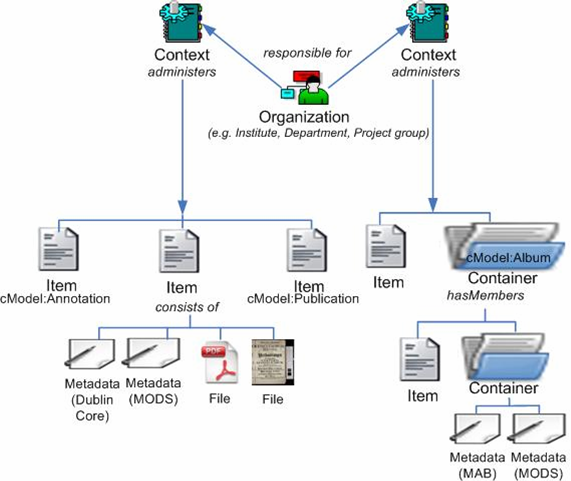Difference between revisions of "ESciDoc Logical Data Model"
m (→Introduction) |
|||
| Line 15: | Line 15: | ||
The diagram above describes the overall relations between the basic classes of objects in an eSciDoc repository. | The diagram above describes the overall relations between the basic classes of objects in an eSciDoc repository. | ||
Content resources are defined by two generic object patterns: Item and Container (Figure 1). An Item resource consists of metadata records (e.g. SISIS MAB record, MODS record, Dublin Core record) and optionally of components that represent the actual content (e.g. PDF file, JPEG file, XML file). A Container resource is an aggregation of other resources that allows grouping of other items or containers. Like the Item resource, Container can be described by multiple metadata records. In addition, each resource is maintained in a single administrative Context. Context resources are created by organizations (e.g. a project group) in accordance with their needs to express rules for content creation, update, quality assurance of metadata, dissemination, preservation, authorization policies, submission policies, etc. | |||
Revision as of 12:07, 25 September 2009
Status: In PROGRESS
Introduction[edit]
This page provides short introduction into the eSciDoc logical data model. It may be used as reference to understand the high-level structure of the data within an eSciDoc repository. The eSciDoc repository manages two general categories of data:
- Resources (content resources) - the content of the repository such as: articles, book, images, image albums, scanned manuscripts, pages etc. Basic object classes in this group are: Item and Container
- MasterData - additional classes of data that are used for management of Resources. Basic object classes in this group ate Context, OrganizationalUnit, ContentModel
A simple delineation between these two data categories may be stated in the following manner: resources are the real content that can be further extended, shared and preserved. Master data are used for content administration and as referenced entities of importance. Master data can also be referenced by objects outside of the core eSciDoc repository.
Basic classes of objects[edit]
The diagram above describes the overall relations between the basic classes of objects in an eSciDoc repository.
Content resources are defined by two generic object patterns: Item and Container (Figure 1). An Item resource consists of metadata records (e.g. SISIS MAB record, MODS record, Dublin Core record) and optionally of components that represent the actual content (e.g. PDF file, JPEG file, XML file). A Container resource is an aggregation of other resources that allows grouping of other items or containers. Like the Item resource, Container can be described by multiple metadata records. In addition, each resource is maintained in a single administrative Context. Context resources are created by organizations (e.g. a project group) in accordance with their needs to express rules for content creation, update, quality assurance of metadata, dissemination, preservation, authorization policies, submission policies, etc.
- Item
- Container
- Context
- Organizational unit
